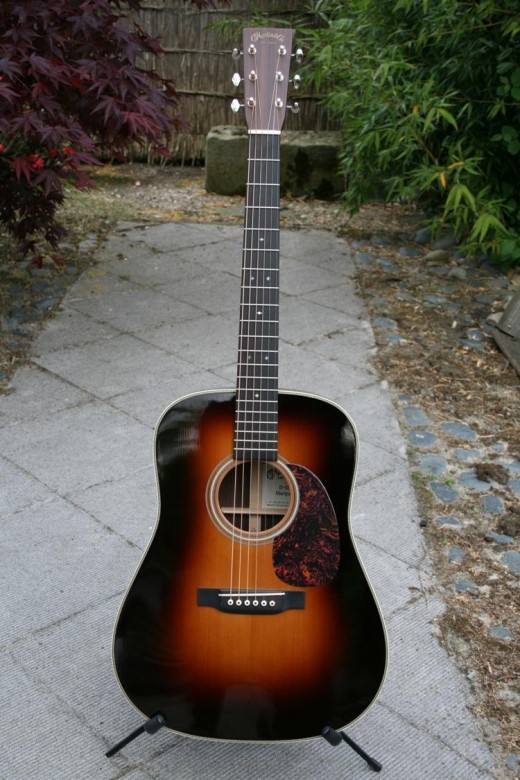Jimmy Page and His Martin D-28 Marquis

C.F. Martin & Company, and The D-28 Dreadnought Guitar
When it comes to steel string acoustic guitars there is no doubt at all who makes the world's most noted and desired model; it is without doubt the Martin D-28. C.F. Martin & Company have been making guitars in the USA since 1833. They are one of the USA's oldest and proudest builders of anything, and luckily for folks like me and you, it is guitars they build. It was nearly one hundred years after Martin started manufacturing guitars that it landed on a design that would become not just its best seller, but the world's best selling design of acoustic guitar, the fourteen frets clear of the body "dreadnought" design.
Now C.F. Martin & Company makes many steel string acoustic guitars that are dreadnought bodies with fourteen frets clear of the body; but of all of them, the D-28 is the guitar that is most often seen, heard, purchased, and well, modified. There are quite a lot of variations of the D-28 produced both now, and in the past by Martin guitars; and the D-28 Marquis is another one of them. Having looked over the specifications of this D-28 design, I'm willing to bet this guitar is going to be one to convince many a man and woman to save his or her pennies, and to save his or her dimes.
East Indian Rosewood Is NOT An Inferior Tone-Wood
As you can see, the Martin D-28 Marquis is anything but cheap, or inexpensive. This is a very serious guitar, and it was made by very serious craftsmen and craftswomen. The people at C.F. Martin & Company only have the world's best reputation in acoustic guitars to defend, and they do defend their reputations very well. Sure, there are smaller manufacturers who produce virtually identical instruments to this one; but the truth is, those will cost more than this one, as Martin can afford to sell such an instrument at a lower price.
The Martin D-28 has always and will always be a rosewood body instrument with a spruce top, and if it says "D-28" on the thing, then it will always be an all solid wood instrument, a professional level instrument. Every D-28 ever made has been a guitar that would last a lifetime, or several lifetimes, if cared for properly. Originally, all Martin D-28 guitars were made from Brazilian rosewood, and Adirondack spruce, for sides and backs, and tops, respectively. As years went by, those specific woods became more and more scarce, and Brazilian rosewood was never an easy wood to work with anyway. Eventually Martin guitars moved to using East Indian rosewood for the backs and sides, and Sitka spruce for the tops of the D-28s, and other D-28 "like" instruments such as the D-35, and the D-45.
I've had some somewhat serious debates on the internet concerning what is "better," or "worse" in tonewoods such as Brazilian rosewood and East Indian rosewood. I've been told I was just plain wrong before, and even that I don't know what I'm talking about. But I assure you I do know what I'm talking about, and that is this: East Indian rosewood isn't a lesser wood than Brazilian rosewood at all, it is just a different wood, and it produces an ever so slightly different sound, while also having a different appearance than its Brazilian rosewood cousin. I've owned a Martin HD-28VR which featured East Indian rosewood, and I own a Santa Cruz dreadnought with Brazilian rosewood; and I've sat and played thousands of guitars over the years. What this Martin Marquis D-28 is, is a D-28 GE, but with East Indian rosewood instead of Brazilian rosewood; and this provides an instrument of very very similar tonal and visual properties for five thousand dollars less.
Dear readers, I can assure you that Brazilian rosewood is beautiful, I assure you that its tonal qualities are very complex, and beautiful. I can also assure you that inexplicably, any acoustic guitar featuring aBrazilian rosewood body is likely to develop hairline cracks in it, despite how well you've taken care of the thing. I can also assure you that for five grand less, the D-28 Marquis isn't a lesser instrument than the D-28GE.
The Martin D-28 Marquis With Sunburst Finish

Specifications
So there you have it, the only difference between the D-28 Marquis and the D-28GE is the species of rosewood used for the backs and sides of the body of the instruments. Let's not forget the five thousand dollars in price difference, that's definitely something to take note of. I suppose, however, that this is still insufficient. One might think the D-28 Marquis to not have anything different about it from the HD-28V, or HD-28VR, and this would be completely inaccurate.
The "GE" in the D-28GE stands for "golden era," and when we say something about a golden era and Martin acoustic guitars, we're talking about one thing, and one thing only; the major models of acoustic guitars Martin was building and selling in the years just prior to world war two. In both the D-18 and the D-28, and all other spruce top models from this time, Martin used Adirondack spruce for the tops, and the braces inside the body of the guitars. So the Marquis instrument is built in this way. Adirondack spruce is said to produce a louder, and clearer tonality than does Sitka spruce, and it is lighter, and stiffer. Generally speaking, when you purchase a guitar with an Adirondack spruce top instead of one with a Sitka spruce top, you can look to spending another one thousand dollars for that upgrade in woods.
There are more differences. The Marquis model D-28, as all Golden Era style martin dreadnoughts, will have a slightly wider neck. The neck on this instrument measures at 1 and 3/4 inches width at the nut. Some people will prefer this neck width, others will not. I think it is very important that someone play ANY guitar in a store before ever purchasing one.
As is standard, the fretboard is black ebony, as is the bridge, mahogany blocks and dovetail neck joints are used, the traditional high X bracing is employed, and the thing comes with limited lifetime warranty to the original owner, and a deluxe hardshell case.
Other perks include fossilized ivory nut, saddle, and bridge pins. Electronics are NOT available for this model of guitar. This is an acoustic picker's dream guitar; it's not something one would typically use in a live performance. This is a guitar too precious to often take on the road.


 12:06 PM
12:06 PM
 Wesman Todd Shaw
Wesman Todd Shaw

0 comments:
Post a Comment